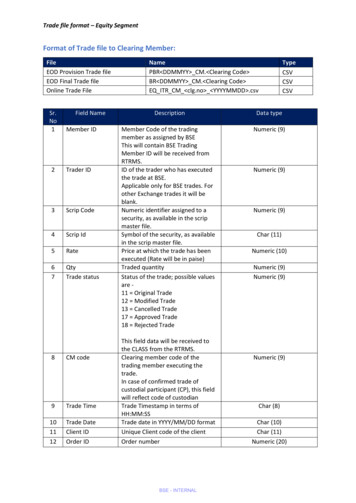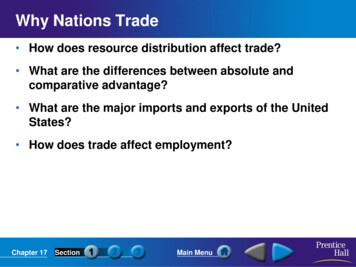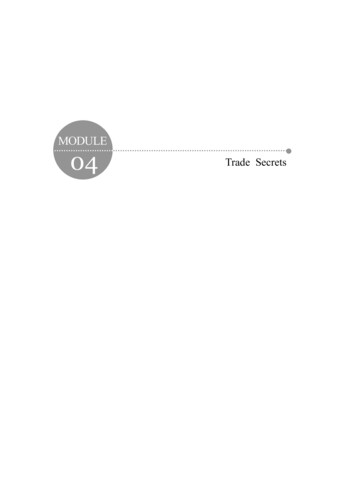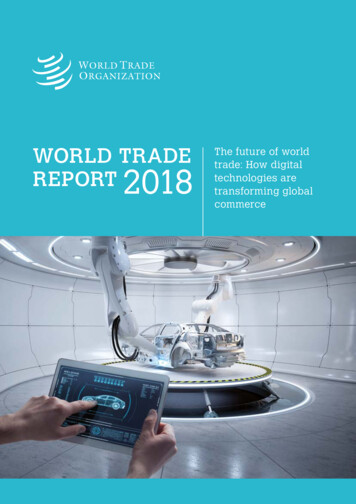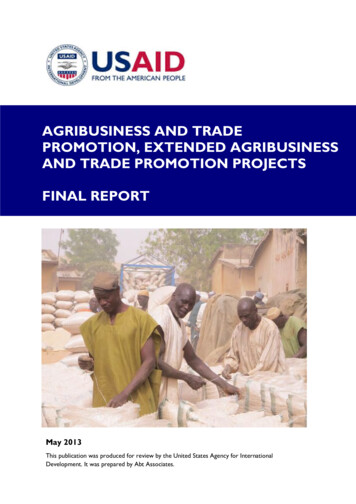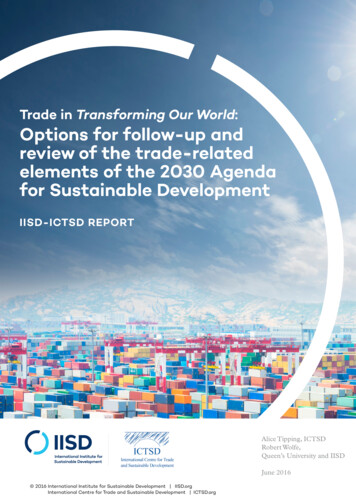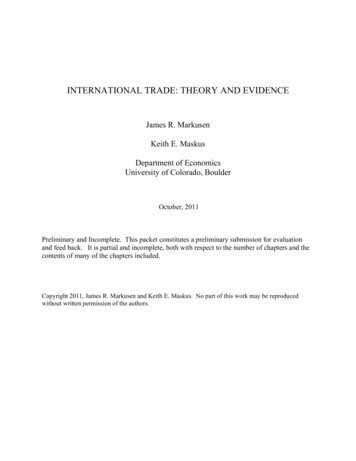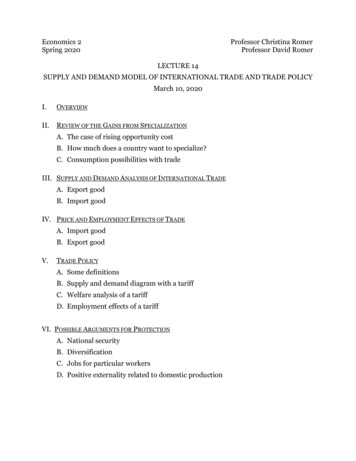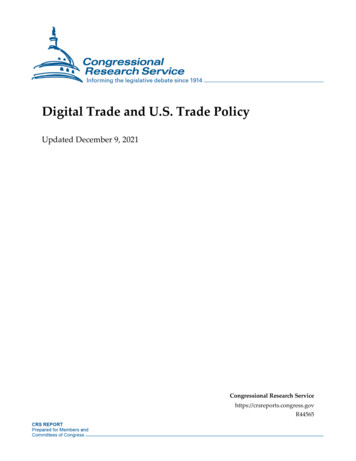
Transcription
Digital Trade and U.S. Trade PolicyUpdated December 9, 2021Congressional Research Servicehttps://crsreports.congress.govR44565
SUMMARYDigital Trade and U.S. Trade PolicyAs the global internet expands and evolves, digital trade has become prominent on the globaltrade and economic policy agenda. According to the Department of Commerce, the “digitaleconomy” accounted for 9.6% of U.S. gross domestic product (GDP) in 2019 and supported 7.7million U.S. jobs, or 5.0% of total U.S. employment in 2019. From 2005 to 2019, real valueadded for the U.S. digital economy grew at an average annual rate of 5.2% per year, outpacingthe 2.2% growth in the overall economy each year. Digital trade has been growing faster thantraditional trade in goods and services, with the pandemic further spurring its expansion.Congress plays an important role in shaping U.S. policy on digital trade, from oversight offederal agencies charged with regulating cross-border data flows to shaping and consideringlegislation to implement new trade rules and disciplines through trade negotiations. Congress alsoworks with the executive branch to identify the appropriate balance between digital trasde andother policy objectives, including privacy and national security.R44565December 9, 2021Rachel F. Fefer,CoordinatorAnalyst in InternationalTrade and FinanceShayerah I. AkhtarSpecialist in InternationalTrade and FinanceMichael D. SutherlandAnalyst in InternationalTrade and FinanceDigital trade includes end-products, such as downloaded movies, and products and services thatrely on or facilitate digital trade, such as streaming services and productivity-enhancing tools likecloud data storage and email. In 2020, U.S. exports of information and communicationstechnologies (ICT) services increased to 84 billion, while services exports that could be ICTenabled totaled 520 billion. Digital trade is growing on a global basis, contributing more to GDP than financial ormerchandise flows.The increase in digital trade raises new challenges in U.S. trade policy, including how to best address new and emergingtrade barriers. As with traditional trade barriers, digital trade constraints can be classified as tariff or nontariff barriers. Inaddition to high tariffs, barriers to digital trade may include localization requirements, cross border data flow limitations,intellectual property rights (IPR) infringement, forced technology transfer, web filtering, economic espionage, andcybercrime exposure or state-directed theft of trade secrets. China’s policies, such as those on internet sovereignty andcybersecurity, particularly pose challenges for U.S. companies.Digital trade issues often overlap and cut across policy areas, such as intellectual property rights (IPR) and national security,raising complex questions for Congress on how to weigh different policy objectives. The Organisation for Economic Cooperation and Development (OECD) points out three potentially conflicting policy goals in the internet economy: (1)enabling the internet; (2) boosting or preserving competition within and outside the internet; and (3) protecting privacy andconsumers, more generally.While no multilateral agreement on digital trade exists in the World Trade Organization (WTO), certain WTO agreementscover some aspects of digital trade. Recent bilateral and plurilateral agreements have begun to address digital trade rules andbarriers more explicitly. For example, the U.S.-Mexico-Canada Agreement (USMCA) and ongoing plurilateral discussions inthe WTO on an e-commerce agreement could address digital trade barriers to varying degrees. Other international fora alsoare discussing digital trade, providing the United States with multiple opportunities to engage in and shape global norms.With workers and firms in the high-tech sector in every U.S. state and congressional district, and with over two-thirds of U.S.jobs requiring digital skills, Congress has an interest in ensuring and developing the global rules and norms of the interneteconomy in line with U.S. laws and norms, and in establishing a U.S. trade policy on digital trade that advances U.S. nationalinterestsCongressional Research Service
Digital Trade and U.S. Trade PolicyContentsIntroduction . 1Role of Digital Trade in the Economy . 2Economic Impact of Digital Trade . 5COVID-19 and Digital Trade. 10Digitization Challenges .11Digital Trade Policy and Barriers . 12Tariff and Tax Barriers . 14Nontariff Barriers . 16Localization Requirements . 16Intellectual Property Rights (IPR) Infringement . 18National Standards and Burdensome Conformity Assessment . 20Filtering, Blocking, and Net Neutrality . 21Cybersecurity Risks . 22U.S. Digital Trade with Key Trading Partners . 24European Union . 24General Data Protection Regulation (GDPR) . 25The EU’s Digital Policy . 26New EU Copyright Rules . 28U.S.-EU Digital Cooperation . 29China . 30“Cyber Sovereignty” and China’s Involvement in Global Internet Governance . 32China’s Emerging Cyberspace and Data Protection Regime . 33U.S. Efforts to Address Digital Trade Barriers and IP Theft Issues in China . 38Digital Trade Provisions in Trade Agreements . 39WTO Provisions . 40General Agreement on Trade in Services (GATS) . 40Declaration on Global Electronic Commerce . 40Information Technology Agreement (ITA) . 41Agreement on Trade-Related Aspects of Intellectual Property Rights (TRIPS) . 41World Intellectual Property Organization (WIPO) Internet Treaties . 42Current WTO Plurilateral Negotiations . 43U.S. Bilateral and Plurilateral Agreements . 44United States-Mexico-Canada Agreement (USMCA) . 45U.S.-Japan Digital Trade Agreement . 46Other International Forums for Digital Trade . 47Issues for Congress . 48FiguresFigure 1. Digital Economy Value Added by Component . 3Figure 2. U.S. Trade in ICT and Potentially ICT-Enabled Services, by Type of Service . 5Figure 3. Cloud Computing Infrastructure Global Market Share . 9Figure 4. Trans-Atlantic Digitally Enabled Services Trade Flows . 25Congressional Research Service
Digital Trade and U.S. Trade PolicyTablesTable 1. American Chamber of Commerce in China 2021 Business Survey . 31ContactsAuthor Information. 50Congressional Research Service
Digital Trade and U.S. Trade PolicyIntroductionThe rapid growth of digital technologies in recent years has created new opportunities for U.S.consumers and businesses but also new challenges in international trade. For example, consumerstoday access e-commerce, social media, telemedicine, and other offerings not imagined thirtyyears ago. Businesses use advanced technology to reach new markets, track global supply chains,analyze big data, and create new products and services. New technologies facilitate economicactivity but also create new trade policy questions and concerns. Data and data flows form a pillarof innovation and economic growth.The “digital economy” accounted for 9.6% of U.S. gross domestic product (GDP) in 2019,including (1) the information and communications technologies (ICT) sector and underlyinginfrastructure, (2) business-to-business and business-to-consumer e‐commerce, and (3) priceddigital services (e.g., internet cloud or intermediary services).1 The digital economy supported 7.7U.S. million jobs, or 5.0% of total U.S. employment in 2019.2 One study found that the “techecommerce ecosystem” added 1.4 million U.S. jobs between September 2017 and September2021, and was the main job producer in 40 states.3 As digital information increases in importancein the U.S. economy, issues related to digital trade have become of growing interest to Congress.While there is no globally accepted definition of digital trade, the U.S. International TradeCommission (USITC) broadly defines digital trade as:The delivery of products and services over the internet by firms in any industry sector, andof associated products such as smartphones and internet-connected sensors. While itincludes provision of e-commerce platforms and related services, it excludes the value ofsales of physical goods ordered online, as well as physical goods that have a digitalcounterpart (such as books, movies, music, and software sold on CDs or DVDs).4A joint report by the Organisation for Economic Cooperation and Development (OCED), WorldTrade Organization (WTO), and International Monetary Fund (IMF) defined digital trade morebroadly as “all trade that is digitally ordered and/or digitally delivered.”5The rules governing digital trade are evolving as governments across the globe experiment withdifferent approaches and consider diverse policy priorities and objectives. Barriers to digitaltrade, such as data localization requirements or protectionist industrial policies, often overlap andcut across sectors. In some cases, policymakers may struggle to balance digital trade objectiveswith other legitimate policy issues, such as national security and privacy. Digital trade policyissues have been in the spotlight recently, due in part to the rise of new trade barriers, heightenedconcerns over data privacy, the rise of misinformation and disinformation, and an increasingnumber of cybersecurity incidents that have affected U.S. consumers, companies, andgovernment entities. These concerns may raise the general U.S. interest in managing cross-borderdata flows, enforcing compliance with existing rules, and establishing new ones. Congress has an1These estimates exclude free digital services. U.S. Bureau of Economic Analysis, Updated Digital EconomyEstimates – June 2021, June 2021. For more information, see onomy.2 Ibid.3 Michael Mandel, “Tech-Ecommerce Drives Job Growth in Most States,” Progressive Policy Institute, October 18,2021, at: erce-drives-job-growth-in-most-states/.4 U.S. International Trade Commission, Global Digital Trade 1: Market Opportunities and Key Foreign TradeRestrictions, August 2017, p.33, at: .5 OECD, WTO, IMF, Handbook on Measuring Digital Trade, Version 1, 2020, ng-Digital-Trade-Version-1.pdf.Congressional Research Service1
Digital Trade and U.S. Trade Policyinterest in ensuring the global rules and norms of the internet economy are in line with U.S. lawsand norms and allow for fair global competition for U.S. businesses and workers.Trade negotiators continue to explore ways to address evolving digital issues in trade agreements,including in the United States’ newest agreements, the U.S.-Mexico-Canada Agreement(USMCA) and the U.S.-Japan Digital Trade Agreement. Congress has an important role inshaping digital trade policy, including overseeing agencies charged with regulating cross-borderdata flows, as part of trade negotiations, and in working with the executive branch to identify theright balance between digital trade and other policy objectives.This report discusses the role of digital trade in the U.S. economy, barriers to digital trade, digitaltrade agreement provisions and negotiations, and other selected policy issues.Role of Digital Trade in the EconomyThe digital economy not only facilitates international trade in goods and services, but is itself aplatform for new digitally-originated services. The internet is enabling technological shifts thatare transforming businesses. The Group of Twenty (G-20) Digital Economy Task Force identifiedthe digital economy as incorporating “all economic activity reliant on, or significantly enhancedby the use of digital inputs, including digital technologies, digital infrastructure, digital servicesand data. It refers to all producers and consumers, including government, that are utilizing thesedigital inputs in their economic activities.”6The Bureau of Economic Analysis (BEA) estimates that, from 2005 to 2019, real value added forthe U.S. digital economy grew at an average annual rate of 5.2% per year, outpacing the 2.2%growth in the overall economy each year.7 During that time, business-to-consumer e-commercewas the fastest growing component of the digital economy (see Figure 1).The increase in the digital economy and digital trade parallels the growth in internet usageglobally. According to one study, over half of the world’s population uses the internet.8 As of2020, 93% of American adults use the internet, including 15% who only access the internet viasmart phones.9 In the third quarter of 2021, approximately 48% of internet traffic in the UnitedStates came from mobile devices.10 Internet traffic is growing globally, with users making almostOECD, “A Roadmap Toward a Common Framework for Measuring the Digital Economy for G20 Digital EconomyTask Force,” Saudi Arabia, 2020, amework-for-measuring-thedigitaleconomy.pdf?utm source Adestra&utm medium email&utm content 20more&utm campaign Stats%20Flash%2C%20August%202020&utm term sdd.7 U.S. Bureau of Economic Analysis, Updated Digital Economy Estimates – June 2021, June 2021. For moreinformation, see onomy.8 Internet World Stats, World Internet Usage and Population Statistics, as of December 31, 2020, athttps://internetworldstats.com/stats.htm.9 Pew Research Center, Internet/Broadband Fact Sheet, April 7, 2021, at ernet-broadband/.10 Statistica, “Percentage of mobile device website traffic in the United States from 1st quarter 2015 to 2nd quarter2021,” September 30, 2021, at Congressional Research Service2
Digital Trade and U.S. Trade Policy4.5 million Google searches each minute in 2019.11 In 2020, the global population is estimated tohave generated 47 zettabytes of data – 534 million times the internet’s size in 1997.12Figure 1. Digital Economy Value Added by ComponentSource: U.S. Bureau of Economic Analysis, June 2021.Cross-border data and communication flows are part of digital trade; they also facilitate trade andthe flows of goods, services, people, and finance, which together drive globalization andinterconnectedness. The highest levels reportedly are the flows between the United States andWestern Europe, Latin America, and China.13 Efforts to impede cross-border data flows coulddecrease efficiency and other potential benefits of digital trade.Powering all these connections and data flows are underlying ICT infrastructure.14 ICT spendingis a large and growing component of the international economy and essential to digital trade andinnovation. World trade in ICT physical goods grew to 2.3 trillion in 2020, with U.S. ICT goodsexports totaling 138 billion.15 U.S. exports of ICT goods accounted for 8.7% of total U.S. goodsexports in 2019.16Semiconductors, a key component in many electronic devices, including systems that undergirdU.S. technological competitiveness and national security, are a top U.S. ICT export. With majorsemiconductor manufacturing facilities in 18 states, the industry is estimated to employ almost aNote: Google search is not available in all countries. OECD, “A Roadmap Toward a Common Framework forMeasuring the Digital Economy for G20 Digital Economy Task Force,” Saudi Arabia, 2020, 2 A zettabyte is one sextillion (1021) bytes. Digital Economy Compass 2019, Statista.com, nomy-compass/.13 James Manyika, et al., “Digital globalization: The new era of global flows,” McKinsey, Global Institute, February16, 2016.14 ICT is an umbrella term that includes any communication device or application, including radio, television, cellularphones, computer and network hardware and software, satellite systems, and associated services and applications.15 United Nations Conference on Trade and Development (UNTAC), UNCTADstat, eView.aspx?ReportId 15850.16 World Bank, Table: ICT goods exports (% of total goods exports) - United .ICTG.ZS.UN?locations US.11Congressional Research Service3
Digital Trade and U.S. Trade Policyquarter million U.S. workers.17 The U.S. semiconductor industry dominates many parts of thesemiconductor supply chain, such as chip design, and it accounted for 48% (or 193 billion) ofthe global market of revenue as of 2020.18 Industry forecasts expect continued strong annualglobal sales growth of 19.7% in 2021 (to an estimated 527 billion) and a further 8.8% in 2022(reaching 573 billion).19 The U.S. share of global semiconductor manufacturing capacity,however, has declined from 37% in 1990 to 12% in 2020.20 Given the importance ofsemiconductors to the digital economy and continued advances in innovation, many policymakerssee U.S. strength in semiconductor technology and fabrication as vital to U.S. economic andnational security interests and have raised concerns about the declining U.S. share insemiconductor manufacturing capacity. Some U.S. policymakers have also expressed concernsabout China's state-led efforts to develop an indigenous vertically-integrated semiconductorindustry, in part to lessen the country’s dependence on U.S. exports.21The growth in traded ICT services is outpacing the growth of traded ICT goods. The OECDestimates that ICT services trade increased 40% from 2010 to 2016. 22 The United States is thethird-largest exporter of ICT services, after Ireland and India.23 ICT services includetelecommunications and computer services, as well as charges for the use of intellectual property(e.g., licenses and rights). ICT-enabled services are those services with outputs delivered remotelyover ICT networks, such as online banking or education. ICT services can augment theproductivity and competitiveness of goods and services. U.S. ICT services are often inputs tofinal demand products that may be exported by other countries, such as China. U.S. exports ofICT services have grown almost every year since 2000 (see Figure 2).24 In 2020, U.S. exports ofICT services grew to 84 billion of U.S. exports, while exports of potentially ICT-enabledservices totaled 520 billion, demonstrating the impact of the internet and digital revolution.2517Semiconductor Industry Association, industry-impact/.Semiconductor Industry Association, “Semiconductor Shortage Highlights Need to Strengthen U.S. ChipManufacturing, Research,” February 4, 2021.19 Semiconductor Industry Association, “Global Semiconductor Sales Increase 1.9% Month-to-Month in April; AnnualSales Projected to Increase 19.7% in 2021, 8.8% in 2021,” June 9, 2021.20 Semiconductor Industry Association, “Invest in Domestic Semiconductor Manufacturing and Research,”https://www.semiconductors.org/chips/, accessed March 12, 2021.21 See CRS Report R46581, Semiconductors: U.S. Industry, Global Competition, and Federal Policy, by Michaela D.Platzer, John F. Sargent Jr., and Karen M. Sutter, CRS Report R46767, China’s New Semiconductor Policies: Issuesfor Congress, by Karen M. Sutter, and Cheng Ting-Fang and Lauly Li, “US-China tech war: Beijing's secretchipmaking champions,” Nikkei Asia, May 5, 2021.22 OECD (2017), OECD Digital Economy Outlook 2017, OECD Publishing, Paris, http://dx.doi.org/10.1787/9789264276284-en.23 Nationmaster, Top Countries in Exports of ICT Services, https://www.nationmaster.com.24 Bureau of Economic Analysis, Table 3.1. U.S. Trade in ICT and Potentially ICT-Enabled Services, by Type ofService, June 30, 2020.25 According to the Department of Commerce, potentially-ICT enabled services are those that “can predominantly bedelivered remotely over ICT networks, a subset of which are actually delivered via that method” and U.S. Bureau ofEconomic Analysis (BEA), Table 3.1. U.S. Trade in ICT and Potentially ICT-Enabled Services, by Type of ServiceOctober 19, 2018.18Congressional Research Service4
Digital Trade and U.S. Trade PolicyFigure 2. U.S.Trade in ICT and Potentially ICT-Enabled Services, by Type of ServiceSource: U.S. Bureau of Economic Analysis, July 2021.ICT and other online services depend on software; the value added to U.S. GDP from supportservices and software has increased over the past decade relative to that of telecommunicationsand hardware.26 According to one estimate, software contributed more than 1.9 trillion to thetotal U.S. value added GDP in 2020 and the software industry accounted for 3.3 million jobsdirectly in 2020, a 7.2% increase from 2018.27 According to an industry group, software and thesoftware industry contributes to jobs in all 50 states, with the value-added GDP of the softwareindustry growing more than 35% in Nevada and Washington from 2018 to 2020.28 The averagesalary of a software developer is over 114,000.29 In addition, the software industry claims thatthe sector funds 27% of all domestic research and development (R&D).30Economic Impact of Digital TradeAs the internet and technology continue to develop rapidly, increasing digitization affects financeand data flows, as well as the movement of goods and people. Beyond simple communication,digital technologies can affect global trade flows in multiple ways and have broad economicimpact. First, digital technology enables the creation of new goods and services, such as e-books,online education, or online banking services. Digital technologies may also raise productivity26BEA, Measuring the Digital Economy: An Update Incorporating Data from the 2018 Comprehensive Update of theIndustry Economic Accounts, March 2018, p.9.27 Ibid.28 Software.org, “Software: Growing US Jobs and the GDP,” eJobs.pdf.29 Ibid.30 Software.org, Software: Supporting US Through COVID, 2021, sthrough-covid-2021/.Congressional Research Service5
Digital Trade and U.S. Trade Policyand/or lower the costs and barriers related to flows of traditional goods and services. Forexample, some refer to the application of emerging technologies as the Fourth IndustrialRevolution (4IR), as companies may rely on radio-frequency identification (RFID) tags andblockchain for global supply chain tracking, 3-D printing based on data files, robotics formanufacturing, or devices or objects connected via the Internet of Things (IoT), and dataanalytics driven by artificial intelligence (AI) (see text box on key technology terms). In addition,digital platforms serve as intermediaries for multiple forms of digital trade, including ecommerce, social media, and cloud computing and allow businesses to reach customers aroundthe globe. In these ways, digitization pervades every industry sector, creating challenges andopportunities for established and new players.Key Technologies Driving InnovationArtificial Intelligence (AI) can generally be thought of as computerized systems that work and react in wayscommonly thought to require intelligence, such as solving complex problems in real-world situations.Blockchain is a distributed record-keeping system (each user can keep a copy of the records) that provides forauditable transactions and secures those transactions with encryption. Using blockchain, each transaction istraceable to a user, each set of transactions is verifiable, and the data in the blockchain cannot be edited withouteach user’s knowledge. Compared to traditional technologies, blockchain allows two or more parties without atrusted relationship to engage in reliable transactions without relying on intermediaries or central authority (e.g., abank or government).Internet of Things (IoT) is a system of interrelated devices connected to a network and/or to one another,exchanging data without necessarily requiring human-to-machine interaction. In other words, IoT is a collection ofelectronic devices that can share information among themselves.Fourth Industrial Revolution (4IR) is characterized by advances in artificial intelligence and machine learning,the Internet of Things, autonomous hardware and software robotics, and advanced data systems that enable realtime and predictive analytics.Source: CRS In Focus IF10608, Overview of Artificial Intelligence, by Laurie A. Harris; CRS In Focus IF10810, Blockchain and International Trade, by Rachel F.Fefer; CRS In Focus IF11239, The Internet of Things (IoT): An Overview, by Patricia Moloney Figliola, John Karr, et. al.; and COVID-19, 4IR, and the Future ofWork, APEC Policy Brief No. 34, June 2020.In an international context, one source estimates that digitally-enabled trade in 2019 was worth 800 billion to 1.5 trillion (3.5%-6.0% of global trade).31 Furthermore, up to 70% of all globaltrade flows could “eventually be meaningfully affected by digitization.” One think tankcategorizes these trade flows to include digitally-sold trade (e.g., e-commerce), digitallyenhanced trade (e.g., services such as movie streaming or car maintenance monitoring thatcomplement physical goods), and digitally-native trade (e.g., non-fungible token (NFT) orcryptocurrency purchase of digital art or digital platforms).These estimates do not quantify the additional benefits of digitization for business efficiency andproductivity, or of increased customer and market access, which enable greater volumes ofinternational trade in all sectors of the economy. Technology advancements have helped driveefficiency and automation across diverse U.S. industries, but may raise other policyconsiderations, such as their impact on employment in the manufacturing sector. Digitizationefficiencies have the potential to both increase international trade and decrease costs. Forexample, one analysis found that logistics optimization technologies could reduce shipping andcustoms processing times by 16% to 28%, boosting overall trade by 6% to 11% by 2030.32 AChristian Ketels, et al., “Global Trade Goes Digital,” Boston Consulting Group, August 12, 2019.Susan Lund, et at., “Globalization in Transition: The Future of Trade and Value Chains,” McKinsey & Company,January 2019 Commercial Assistant - Open to: All Interested Applicants / All Sources3132Congressional Research Service6
Digital Trade and U.S. Trade Policystudy of small and medium-sized enterprises (SMEs) in Asia found that digital tools reducedexport costs by 82%, and transaction times by 29%.33One example of digitization driving efficiencies is the use of AI to help companies forecastdemand, understand trends and identify patterns, and allow companies to quickly adjust shippingroutes or optimize supply chains
analyze big data, and create new products and services. New technologies facilitate economic activity but also create new trade policy questions and concerns. Data and data flows form a pillar of innovation and economic growth. The "digital economy" accounted for 9.6% of U.S. gross domestic product (GDP) in 2019,
